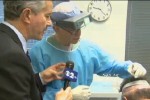CBS 2 News Anchor Chris Wragge: These days we’ve seen robots doing everything from vacuuming our floors to building cars. You may have even had surgery done with the help of a robot. But what about something personal and cosmetic like a hair transplant? Our Dr. Max Gomez tells us about a robot doing just that.
Dr. Max Gomez: Well that’s right Chris. Now first we should make clear that robots in medicine don’t act alone, at least not yet. They’re always under the direction of a doctor. Now, that said, what robots are really good at are tedious, repetitive tasks that need to be done quickly and accurately. Something like a hair transplant.
Dr. Gomez: A full head of hair is called a person’s “crowning glory”. Sure, going bald is a common fashion statement, but most people are like Sam.
Sam, Hair Transplant Patient: I wanted more hair on my head, obviously, and I didn’t want to be bothered with any of the other treatments that are available.
Dr. Gomez: For Sam that meant a hair transplant, where donor hair follicles are taken from the back of the head and transplanted to the thinning areas, usually on top or the former hairline.
Dr. Robert M. Bernstein: The hair on the back and sides of the scalp are not effected by the same genetic process that the hair on the top of the scalp is.
Dr. Gomez: That donor hair is typically taken from a strip of scalp that is cut out and then sutured closed, but that’s not the best choice for everyone.
Dr. Bernstein: Some patients, who want to wear their hair very short, that line can be a problem. Also, there are some people who are at risk of having a wider scar.
Dr. Gomez: The solution is to randomly extract individual follicular units, small groups of one to four hairs.
Dr. Bernstein: The procedure is very labor intensive and you have to do thousands of these in a single session.
Dr. Gomez: Enter the ARTAS robot. It’s a sophisticated hair mapping and extraction system. Once the donor area is identified, the robot maps all of the follicles, and then randomly extracts them with a series of punches. It can even tell the angle the hair is growing at to avoid damaging it.
Dr. Bernstein: It is much more precise than the human hand. It doesn’t tire if you’re doing thousands of grafts. It’s the same every single time.
Dr. Gomez: And here’s the result a few weeks later. Even with short hair, the random extraction means it’s virtually impossible to tell where the donor hairs came from.
Now, the rest of the transplant procedure is pretty much the same as without the robot. That’s where the art comes in. Deciding where, how many, how dense, and at what angle the donor hairs are inserted, that’s what makes a hair transplant look natural. And a well-done transplant is amazingly natural.


 Dr. Bernstein was featured in a CBS News report on
Dr. Bernstein was featured in a CBS News report on 


